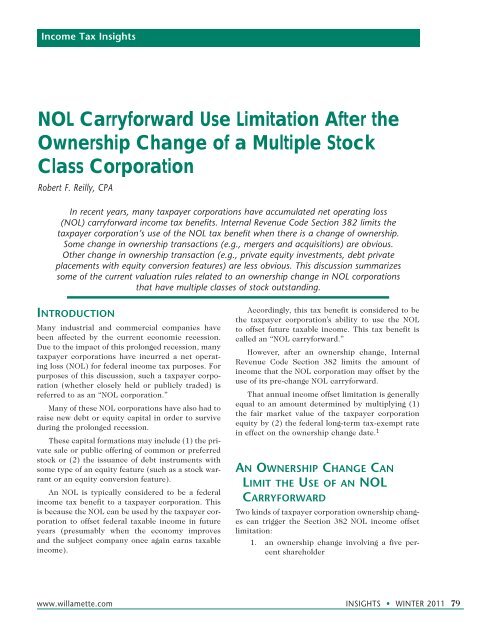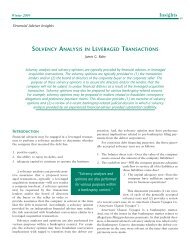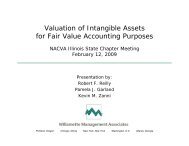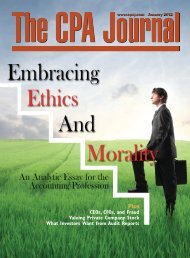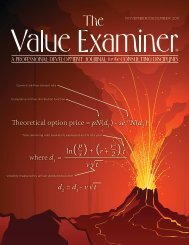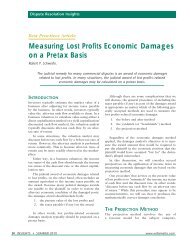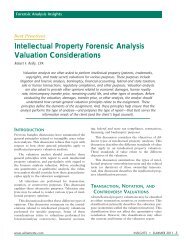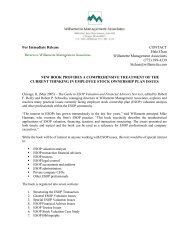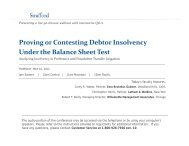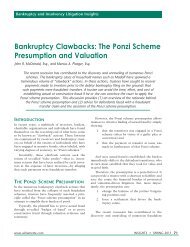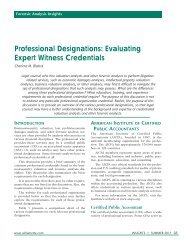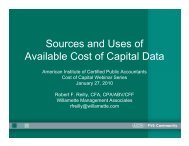NOL Carryforward Use Limitation After the Ownership Change of a ...
NOL Carryforward Use Limitation After the Ownership Change of a ...
NOL Carryforward Use Limitation After the Ownership Change of a ...
You also want an ePaper? Increase the reach of your titles
YUMPU automatically turns print PDFs into web optimized ePapers that Google loves.
Income Tax Insights<br />
<strong>NOL</strong> <strong>Carryforward</strong> <strong>Use</strong> <strong>Limitation</strong> <strong>After</strong> <strong>the</strong><br />
<strong>Ownership</strong> <strong>Change</strong> <strong>of</strong> a Multiple Stock<br />
Class Corporation<br />
Robert F. Reilly, CPA<br />
In recent years, many taxpayer corporations have accumulated net operating loss<br />
(<strong>NOL</strong>) carryforward income tax benefits. Internal Revenue Code Section 382 limits <strong>the</strong><br />
taxpayer corporation’s use <strong>of</strong> <strong>the</strong> <strong>NOL</strong> tax benefit when <strong>the</strong>re is a change <strong>of</strong> ownership.<br />
Some change in ownership transactions (e.g., mergers and acquisitions) are obvious.<br />
O<strong>the</strong>r change in ownership transaction (e.g., private equity investments, debt private<br />
placements with equity conversion features) are less obvious. This discussion summarizes<br />
some <strong>of</strong> <strong>the</strong> current valuation rules related to an ownership change in <strong>NOL</strong> corporations<br />
that have multiple classes <strong>of</strong> stock outstanding.<br />
Introduction<br />
Many industrial and commercial companies have<br />
been affected by <strong>the</strong> current economic recession.<br />
Due to <strong>the</strong> impact <strong>of</strong> this prolonged recession, many<br />
taxpayer corporations have incurred a net operating<br />
loss (<strong>NOL</strong>) for federal income tax purposes. For<br />
purposes <strong>of</strong> this discussion, such a taxpayer corporation<br />
(whe<strong>the</strong>r closely held or publicly traded) is<br />
referred to as an “<strong>NOL</strong> corporation.”<br />
Many <strong>of</strong> <strong>the</strong>se <strong>NOL</strong> corporations have also had to<br />
raise new debt or equity capital in order to survive<br />
during <strong>the</strong> prolonged recession.<br />
These capital formations may include (1) <strong>the</strong> private<br />
sale or public <strong>of</strong>fering <strong>of</strong> common or preferred<br />
stock or (2) <strong>the</strong> issuance <strong>of</strong> debt instruments with<br />
some type <strong>of</strong> an equity feature (such as a stock warrant<br />
or an equity conversion feature).<br />
An <strong>NOL</strong> is typically considered to be a federal<br />
income tax benefit to a taxpayer corporation. This<br />
is because <strong>the</strong> <strong>NOL</strong> can be used by <strong>the</strong> taxpayer corporation<br />
to <strong>of</strong>fset federal taxable income in future<br />
years (presumably when <strong>the</strong> economy improves<br />
and <strong>the</strong> subject company once again earns taxable<br />
income).<br />
Accordingly, this tax benefit is considered to be<br />
<strong>the</strong> taxpayer corporation’s ability to use <strong>the</strong> <strong>NOL</strong><br />
to <strong>of</strong>fset future taxable income. This tax benefit is<br />
called an “<strong>NOL</strong> carryforward.”<br />
However, after an ownership change, Internal<br />
Revenue Code Section 382 limits <strong>the</strong> amount <strong>of</strong><br />
income that <strong>the</strong> <strong>NOL</strong> corporation may <strong>of</strong>fset by <strong>the</strong><br />
use <strong>of</strong> its pre-change <strong>NOL</strong> carryforward.<br />
That annual income <strong>of</strong>fset limitation is generally<br />
equal to an amount determined by multiplying (1)<br />
<strong>the</strong> fair market value <strong>of</strong> <strong>the</strong> taxpayer corporation<br />
equity by (2) <strong>the</strong> federal long-term tax-exempt rate<br />
in effect on <strong>the</strong> ownership change date. 1<br />
An <strong>Ownership</strong> <strong>Change</strong> Can<br />
Limit <strong>the</strong> <strong>Use</strong> <strong>of</strong> an <strong>NOL</strong><br />
<strong>Carryforward</strong><br />
Two kinds <strong>of</strong> taxpayer corporation ownership changes<br />
can trigger <strong>the</strong> Section 382 <strong>NOL</strong> income <strong>of</strong>fset<br />
limitation:<br />
1. an ownership change involving a five percent<br />
shareholder<br />
www.willamette.com INSIGHTS • WINTER 2011 79
stock trading price (for a public corporation) or<br />
in <strong>the</strong> stock fair market value (for a closely held<br />
corporation) will complicate <strong>the</strong> determination <strong>of</strong><br />
whe<strong>the</strong>r <strong>the</strong> future use <strong>of</strong> <strong>the</strong> <strong>NOL</strong> carryforward<br />
may be limited.<br />
2. any tax-free reorganization <strong>of</strong> <strong>the</strong> corporation<br />
(with a few exceptions)<br />
In ei<strong>the</strong>r case, a five percent shareholder must<br />
have increased his or her ownership percentage in<br />
<strong>the</strong> <strong>NOL</strong> corporation by more than 50 percent (over<br />
his or her lowest pre-change ownership percentage)<br />
within three years <strong>of</strong> <strong>the</strong> ownership change event. 2<br />
The second kind <strong>of</strong> <strong>NOL</strong> limitation ownership<br />
change event is usually more obvious. If <strong>the</strong> stock<br />
<strong>of</strong> <strong>the</strong> <strong>NOL</strong> corporation is merged or acquired in a<br />
tax-free transaction structure (e.g., a cash for stock<br />
purchase, a stock for stock exchange, etc.), <strong>the</strong>n <strong>the</strong><br />
Section 382 <strong>NOL</strong> limitation applies.<br />
The first type <strong>of</strong> <strong>NOL</strong> limitation ownership<br />
change event is not always so obvious. For example,<br />
an ownership change triggering event could include<br />
<strong>the</strong> private placement (or <strong>the</strong> public <strong>of</strong>fering) <strong>of</strong> a<br />
relatively small amount <strong>of</strong> equity, an equity investment<br />
by a private equity fund, <strong>the</strong> exercise <strong>of</strong> stock<br />
options by <strong>the</strong> taxpayer corporation employees, or<br />
o<strong>the</strong>r similar event.<br />
Ei<strong>the</strong>r public or private capital placements may<br />
result in a Section 382 “ownership change” in <strong>the</strong><br />
<strong>NOL</strong> corporation. And, <strong>the</strong> Section 382 determination<br />
<strong>of</strong> an “ownership change” by a five percent<br />
shareholder is typically based on a valuation calculation,<br />
as discussed below.<br />
Particularly after a capital formation event, <strong>the</strong><br />
<strong>NOL</strong> corporation may have several classes <strong>of</strong> stock<br />
outstanding (voting and nonvoting stock; common<br />
and preferred stock; class A and class B common<br />
stock; etc.).<br />
For an <strong>NOL</strong> corporation with multiple classes<br />
<strong>of</strong> stock outstanding, any price fluctuation in <strong>the</strong><br />
Multiple Stock Class <strong>NOL</strong><br />
Corporations<br />
Section 382(l)(3)(C) specifically addresses <strong>the</strong> issue<br />
<strong>of</strong> fluctuations in stock price/value (depending on<br />
whe<strong>the</strong>r <strong>the</strong> stock is public or private) for an <strong>NOL</strong><br />
corporation with multiple classes <strong>of</strong> stock outstanding.<br />
Section 382(l)(3)(C) states: “Except as provided<br />
in regulations, any change in proportionate ownership<br />
which is attributable solely to fluctuations in<br />
<strong>the</strong> relative fair market values <strong>of</strong> different classes <strong>of</strong><br />
stock shall not be taken into account.”<br />
However, <strong>the</strong> regulations do not specifically<br />
address how to apply Section 382(l)(3)(C).<br />
Therefore, <strong>the</strong> multi-stock class <strong>NOL</strong> corporation<br />
(and its tax and valuation advisers) have little pr<strong>of</strong>essional<br />
guidance related to a valuation issue that<br />
directly affects <strong>the</strong> taxpayer corporation’s ability to<br />
use its <strong>NOL</strong>.<br />
In prior years, <strong>the</strong> Internal Revenue Service indicated<br />
its position on this change <strong>of</strong> ownership issue<br />
through <strong>the</strong> issuance <strong>of</strong> private letter rulings.<br />
Most recently, <strong>the</strong> Service issued Notice 2010-50<br />
regarding <strong>the</strong> <strong>NOL</strong> limitation related to a change <strong>of</strong><br />
corporate ownership for a taxpayer corporation with<br />
multiple stock classes.<br />
Prior Guidance on Section<br />
382(l)(3)(C)<br />
Since 2004, <strong>the</strong> Service issued a series <strong>of</strong> letter rulings<br />
that have addressed <strong>the</strong> application <strong>of</strong> Section<br />
382(l)(3)(C).<br />
The earlier letter rulings generally indicated<br />
that: “on any testing date, in determining <strong>the</strong> ownership<br />
percentage <strong>of</strong> any 5% shareholder, <strong>the</strong> value<br />
<strong>of</strong> such shareholder’s stock, relative to <strong>the</strong> value <strong>of</strong><br />
all o<strong>the</strong>r stock <strong>of</strong> a loss corporation issued subsequent<br />
to such acquisition date shall also be considered<br />
to remain constant since <strong>the</strong> acquisition date.”<br />
In <strong>the</strong> more recent letter rulings (e.g., Letter<br />
Rulings 201017004, 200952004, and 200901003),<br />
<strong>the</strong> Service adopted a valuation procedure that is<br />
80 INSIGHTS • WINTER 2011 www.willamette.com
commonly referred to as <strong>the</strong> hold constant principle<br />
(HCP).<br />
For example, in Letter Ruling 201017004, <strong>the</strong><br />
Service concluded that <strong>the</strong> “[t]axpayer may apply<br />
a method employing <strong>the</strong> Hold Constant Principle<br />
to determine <strong>the</strong> increase in percentage ownership<br />
<strong>of</strong> each <strong>of</strong> its 5% shareholders on each <strong>of</strong> its testing<br />
dates . . . for purposes <strong>of</strong> Section 382.”<br />
A comprehensive explanation <strong>of</strong> <strong>the</strong> <strong>NOL</strong> use<br />
limitations due to a change <strong>of</strong> ownership in a multiple<br />
stock class corporation is beyond <strong>the</strong> scope <strong>of</strong><br />
this discussion.<br />
However, (1) <strong>the</strong> application <strong>of</strong> <strong>the</strong> HCP and (2)<br />
<strong>the</strong> current Internal Revenue Service interpretation<br />
<strong>of</strong> Section 382(l)(3)(C)—as outlined in Notice 2010-<br />
50—are discussed below.<br />
Internal Revenue Service<br />
Notice 2010-50<br />
Recently, <strong>the</strong> Service provided Section 382(l)(3)<br />
(C) interim guidance to multiple stock class <strong>NOL</strong><br />
corporations with <strong>the</strong> issuance <strong>of</strong> Notice 2010-50.<br />
This Notice appears to be <strong>the</strong> first guidance from <strong>the</strong><br />
Service that actually provides specific application<br />
guidance for Section 382(l)(3)(C).<br />
In particular, this Notice describes <strong>the</strong> acceptable<br />
valuation methods to account for any fluctuations<br />
in <strong>the</strong> value <strong>of</strong> one class <strong>of</strong> <strong>the</strong> <strong>NOL</strong> corporation<br />
stock relative to ano<strong>the</strong>r class <strong>of</strong> <strong>the</strong> <strong>NOL</strong><br />
corporation stock for <strong>the</strong> purpose <strong>of</strong> determining<br />
<strong>the</strong> Section 382 <strong>NOL</strong> limitation.<br />
In <strong>the</strong> Notice, <strong>the</strong> Service states that it will<br />
accept certain valuation methods for taking into<br />
account, or for not taking into account, any fluctuation<br />
in <strong>the</strong> <strong>NOL</strong> corporation stock value.<br />
As summarized below, <strong>the</strong> Notice describes two<br />
valuation methods that <strong>the</strong> Service will accept in<br />
<strong>the</strong> application <strong>of</strong> Section 382(l)(3)(C) to quantify<br />
<strong>the</strong> <strong>NOL</strong> limitation for a multiple stock class corporation.<br />
These two valuation methods are called:<br />
1. <strong>the</strong> full value method (FVM) and<br />
2. <strong>the</strong> HCP.<br />
1. <strong>the</strong> fair market value <strong>of</strong> <strong>the</strong> stock owned by<br />
that individual shareholder relative to<br />
2. <strong>the</strong> total fair market value <strong>of</strong> <strong>the</strong> <strong>NOL</strong> corporation<br />
total outstanding stock on a testing<br />
date.<br />
Accordingly, under <strong>the</strong> FVM, all <strong>of</strong> <strong>the</strong> <strong>NOL</strong> corporation<br />
shares are effectively marked to market.<br />
This is true regardless <strong>of</strong> whe<strong>the</strong>r <strong>the</strong> individual<br />
shareholder actively participates in—or is o<strong>the</strong>rwise<br />
a party to—<strong>the</strong> change <strong>of</strong> ownership transaction.<br />
This valuation method provides for a very narrow<br />
interpretation <strong>of</strong> Section 382(l)(3)(C). That<br />
is, this FVM valuation method gives effect to <strong>the</strong><br />
Section 382(l)(3)(C) statutory language by not<br />
requiring an accounting for <strong>the</strong> daily fluctuations<br />
in fair market value between <strong>the</strong> different classes <strong>of</strong><br />
<strong>the</strong> <strong>NOL</strong> corporation stock that may occur between<br />
testing dates.<br />
The Hold Constant Principle<br />
In contrast, <strong>the</strong> HCP gives effect to <strong>the</strong> Section<br />
382(l)(3)(C) statutory language by factoring out<br />
fluctuations in <strong>the</strong> fair market value <strong>of</strong> <strong>the</strong> <strong>NOL</strong> corporation<br />
stock held by passive shareholders across<br />
multiple testing dates.<br />
In <strong>the</strong> Notice, <strong>the</strong> Service states:<br />
. . . <strong>the</strong> Hold Constant Principle, <strong>the</strong> value<br />
<strong>of</strong> a share, relative to <strong>the</strong> value <strong>of</strong> all o<strong>the</strong>r<br />
stock <strong>of</strong> <strong>the</strong> corporation, is established on<br />
<strong>the</strong> date that share is acquired by a particular<br />
shareholder. On subsequent testing<br />
dates, <strong>the</strong> percentage interest represented<br />
by that share (<strong>the</strong> “tested share”) is <strong>the</strong>n<br />
determined by factoring out fluctuations in<br />
The Full Value Method<br />
Under <strong>the</strong> FVM, <strong>the</strong> determination <strong>of</strong> <strong>the</strong> ownership<br />
percentage in <strong>the</strong> <strong>NOL</strong> corporation stock owned by<br />
any shareholder is based on:<br />
www.willamette.com INSIGHTS • WINTER 2011 81
Notice 2010-50 provides <strong>the</strong> following illustrative<br />
example <strong>of</strong> <strong>the</strong> application <strong>of</strong> <strong>the</strong> HCP:<br />
Example 1: Upon formation, X Corp. issues<br />
$20 <strong>of</strong> convertible preferred stock to A and<br />
two shares <strong>of</strong> common stock to B for $80,<br />
such that A and B own 20% and 80% <strong>of</strong> X,<br />
respectively. X’s fortunes deteriorate, and<br />
two years later, when <strong>the</strong> common stock<br />
has a value <strong>of</strong> $2.50 per share and <strong>the</strong> preferred<br />
stock has a value <strong>of</strong> $20, B sells one<br />
share <strong>of</strong> common stock to C. At <strong>the</strong> time <strong>of</strong><br />
that sale, X is a loss corporation. On that<br />
testing date, although A actually owns 80%<br />
<strong>of</strong> X’s value, A will be treated as owning<br />
20% <strong>of</strong> X’s value for purposes <strong>of</strong> Sec. 382(g)<br />
under <strong>the</strong> HCP.<br />
<strong>the</strong> relative values <strong>of</strong> <strong>the</strong> loss corporation’s<br />
share classes that have occurred since <strong>the</strong><br />
acquisition date <strong>of</strong> <strong>the</strong> tested share.<br />
In o<strong>the</strong>r words, under <strong>the</strong> HCP, for an <strong>NOL</strong> corporation<br />
with multiple stock classes outstanding:<br />
• The fair market value ratios between and<br />
among <strong>the</strong> various <strong>NOL</strong> corporation stock<br />
classes are fixed, or “held constant,” on <strong>the</strong><br />
date that <strong>the</strong> particular share is acquired.<br />
• Any change in ownership that is attributable<br />
solely to fluctuations in <strong>the</strong> relative<br />
fair market values <strong>of</strong> <strong>the</strong> different classes<br />
<strong>of</strong> <strong>NOL</strong> corporation stock is not taken into<br />
account when determining an ownership<br />
change.<br />
• The “factoring out” process generally continues<br />
for <strong>the</strong> particular share—until <strong>the</strong><br />
shareholder is no longer treated as owning<br />
<strong>the</strong> tested share for Section 382 purposes.<br />
In contrast to <strong>the</strong> FVM, <strong>the</strong> HCP is individualized<br />
for each individual stock acquisition by each<br />
individual shareholder.<br />
And, under <strong>the</strong> HCP, <strong>the</strong> ownership percentage<br />
<strong>of</strong> each tested share is adjusted for:<br />
1. <strong>the</strong> dilutive effects <strong>of</strong> any stock issuances<br />
and<br />
2. <strong>the</strong> accretive effects <strong>of</strong> any stock redemptions<br />
subsequent to <strong>the</strong> original share<br />
acquisition date.<br />
As explained in this illustrative example, under<br />
<strong>the</strong> HCP, <strong>the</strong> increase in shareholder A’s ownership<br />
percentage interest (i.e., 60%) is attributed solely to<br />
fluctuations in <strong>the</strong> relative fair market value <strong>of</strong> <strong>the</strong><br />
<strong>NOL</strong> corporation common stock.<br />
The only share that is marked to fair market<br />
value is <strong>the</strong> one share that is acquired by shareholder<br />
C. That one share represents 10% <strong>of</strong> <strong>the</strong> <strong>NOL</strong><br />
corporation’s total equity value on <strong>the</strong> date <strong>of</strong> <strong>the</strong><br />
stock acquisition.<br />
When determining an ownership change under<br />
<strong>the</strong> HCP, <strong>the</strong> ownership percentage increase as a<br />
consequence <strong>of</strong> <strong>the</strong> acquisition by shareholder C is<br />
only 10%. Therefore, according to <strong>the</strong> HCP, no ownership<br />
change has occurred.<br />
This HCP application illustrative example is consistent<br />
with <strong>the</strong> Service’s previous position in <strong>the</strong><br />
prior letter rulings related to Section 382(l)(3)(C).<br />
There are two valuation procedures that implement<br />
<strong>the</strong> HCP valuation method specifically outlined<br />
in Notice 2010-50. These two alternative valuation<br />
procedures are summarized below.<br />
Alternative Procedure No. 1—Lookback<br />
from <strong>the</strong> Testing Date<br />
This valuation procedure recalculates <strong>the</strong> HCP represented<br />
by <strong>the</strong> tested share in order to factor out<br />
any changes in its relative fair market value since<br />
that share’s acquisition date.<br />
Under alternative procedure 1, <strong>the</strong> percentage<br />
interest represented by a tested share on a testing<br />
date is determined at <strong>the</strong> beginning with <strong>the</strong> fair<br />
market value <strong>of</strong> <strong>the</strong> tested share on <strong>the</strong> testing date.<br />
82 INSIGHTS • WINTER 2011 www.willamette.com
Then, <strong>the</strong> percentage interest is adjusted by <strong>the</strong><br />
subsequent changes in <strong>the</strong> fair market value <strong>of</strong> <strong>the</strong><br />
tested share relative to <strong>the</strong> changes in <strong>the</strong> total fair<br />
market value <strong>of</strong> all <strong>the</strong> <strong>NOL</strong> corporation stock that<br />
have occurred since <strong>the</strong> tested share’s acquisition<br />
date.<br />
Alternative Procedure No. 2—<br />
Ongoing Adjustments from <strong>the</strong><br />
Acquisition Date<br />
This valuation procedure tracks <strong>the</strong> percentage<br />
interest represented by <strong>the</strong> tested share from <strong>the</strong><br />
date <strong>of</strong> acquisition forward. This valuation procedure<br />
adjusts for:<br />
1. any subsequent stock dispositions and<br />
2. <strong>the</strong> subsequent issuance or redemption <strong>of</strong><br />
o<strong>the</strong>r stock.<br />
Under alternative procedure 2, to <strong>the</strong> extent a<br />
particular shareholder does not engage in any stock<br />
acquisitions or dispositions, <strong>the</strong>n <strong>the</strong> percentage<br />
ownership calculation “rolls over” from one testing<br />
date to ano<strong>the</strong>r.<br />
Under alternative procedure 1, <strong>the</strong> <strong>NOL</strong> corporation<br />
generally determines <strong>the</strong> relative fair market<br />
value <strong>of</strong> its stock shares:<br />
1. at <strong>the</strong> beginning <strong>of</strong> <strong>the</strong> testing period or<br />
2. at an earlier date.<br />
In contrast, this valuation procedure may not<br />
necessarily be <strong>the</strong> case under alternative procedure<br />
2. Therefore, alternative procedure 2 may involve<br />
fewer calculations on any particular testing date<br />
than alternative procedure 1.<br />
Common Elements <strong>of</strong> Both<br />
<strong>of</strong> <strong>the</strong> HCP Valuation<br />
Procedures as Described in<br />
Notice 2010-50<br />
First, under ei<strong>the</strong>r <strong>of</strong> <strong>the</strong> HCP alternative valuation<br />
procedures, an <strong>NOL</strong> corporation does not factor out<br />
fair market value fluctuations related to an acquisition.<br />
Instead, for any share that is acquired, <strong>the</strong> <strong>NOL</strong><br />
corporation determines <strong>the</strong> percentage interest<br />
related to that share by comparing its fair market<br />
value to <strong>the</strong> fair market value <strong>of</strong> all <strong>NOL</strong> corporation<br />
outstanding stock on <strong>the</strong> acquisition date.<br />
Second, under ei<strong>the</strong>r <strong>of</strong> <strong>the</strong> HCP alternative procedures,<br />
a shareholder’s increase in proportionate<br />
interest during a testing period will be reduced by<br />
any share dispositions.<br />
The Notice describes two valuation methods that<br />
may be used to account for such share dispositions:<br />
1. <strong>the</strong> fair market value method<br />
2. <strong>the</strong> share equivalent method<br />
Under <strong>the</strong> fair market value method, <strong>the</strong> effect<br />
<strong>of</strong> a shareholder’s share disposition is based on <strong>the</strong><br />
percentage ownership that <strong>the</strong> sold share represents<br />
on <strong>the</strong> date <strong>of</strong> its disposition—as opposed to <strong>the</strong><br />
percentage represented by that share on <strong>the</strong> date <strong>of</strong><br />
its acquisition.<br />
Under <strong>the</strong> share equivalent method, <strong>the</strong> effect <strong>of</strong><br />
a share disposition is based on <strong>the</strong> percentage ownership<br />
that <strong>the</strong> sold share represented on ano<strong>the</strong>r<br />
testing date during <strong>the</strong> testing period in which <strong>the</strong><br />
selling shareholder acquired shares.<br />
The Notice provides <strong>the</strong> following illustrative<br />
example <strong>of</strong> <strong>the</strong> application <strong>of</strong> <strong>the</strong> share equivalent<br />
method:<br />
Example 2: A purchases 10 shares <strong>of</strong> X’s<br />
common stock for $10 on testing date 1,<br />
when each share <strong>of</strong> common stock represents<br />
1% <strong>of</strong> X. X is a loss corporation. On<br />
testing date 1, A also holds two shares <strong>of</strong><br />
participating preferred stock, with each<br />
share valued at $2 and each preferred share<br />
representing 2% <strong>of</strong> X. On testing date 2, A<br />
disposes <strong>of</strong> one share <strong>of</strong> <strong>the</strong> preferred stock.<br />
Under a share equivalent method, A may be<br />
considered to have disposed <strong>of</strong> two shares<br />
<strong>of</strong> common stock, which is <strong>the</strong> common<br />
share equivalent <strong>of</strong> one share <strong>of</strong> preferred<br />
stock as determined on <strong>the</strong> acquisition date<br />
<strong>of</strong> <strong>the</strong> common stock.<br />
Third, <strong>the</strong> Notice states that (1) if an <strong>NOL</strong> corporation<br />
determines <strong>the</strong> effect <strong>of</strong> a share disposition<br />
based on <strong>the</strong> percentage represented by <strong>the</strong> sold<br />
share on <strong>the</strong> share acquisition date, and (2) if a five<br />
percent shareholder has made multiple share acquisitions<br />
and dispositions <strong>of</strong> <strong>the</strong> <strong>NOL</strong> corporation<br />
stock, <strong>the</strong>n—under ei<strong>the</strong>r <strong>of</strong> <strong>the</strong>se two valuation<br />
methods—<strong>the</strong> <strong>NOL</strong> corporation must also determine<br />
<strong>the</strong> source <strong>of</strong> <strong>the</strong> shares that were disposed <strong>of</strong>.<br />
www.willamette.com INSIGHTS • WINTER 2011 83
“Using ei<strong>the</strong>r current<br />
or historical fair market<br />
values can produce<br />
substantially different<br />
outcomes for purposes<br />
<strong>of</strong> determining<br />
whe<strong>the</strong>r an ownership<br />
change has occurred.”<br />
In that case, <strong>the</strong> <strong>NOL</strong><br />
corporation may treat<br />
<strong>the</strong> sold shares:<br />
1. as being sourced pro<br />
rata from all share<br />
acquisitions,<br />
2. as being sourced<br />
first from <strong>the</strong> most<br />
recent share acquisition<br />
(LIFO), or<br />
3. as being sourced<br />
first from <strong>the</strong> first<br />
share acquisition<br />
(FIFO).<br />
Fourth, to <strong>the</strong> extent that a shareholder remains<br />
as an owner <strong>of</strong> <strong>the</strong> <strong>NOL</strong> corporation (or <strong>of</strong> its successor),<br />
<strong>the</strong> original acquisition date and any o<strong>the</strong>r<br />
hold constant characteristics are preserved.<br />
In addition, <strong>the</strong> <strong>NOL</strong> corporation is not treated<br />
as disposing <strong>of</strong>—or acquiring—<strong>the</strong> <strong>NOL</strong> corporation<br />
stock. The Notice states that this principle applies<br />
to value-for-value recapitalizations in which a shareholder<br />
exchanges his or her <strong>NOL</strong> corporation stock<br />
for o<strong>the</strong>r <strong>NOL</strong> corporation stock.<br />
This principle also applies to certain reorganizations<br />
and holding company formations.<br />
Fifth, Section 382 also takes into account <strong>NOL</strong><br />
corporation stock redemptions and issuances by <strong>the</strong><br />
<strong>NOL</strong> corporation for purposes <strong>of</strong> tracking five percent<br />
shareholder ownership percentages.<br />
For Section 382 purposes, a stock redemption<br />
constitutes a pro rata acquisition by a nonredeeming<br />
shareholder <strong>of</strong> <strong>the</strong> redeemed shares.<br />
For Section 382 purposes, a stock issuance constitutes:<br />
1. a pro rata sale <strong>of</strong> shares by a shareholder<br />
who holds stock immediately before <strong>the</strong><br />
issuance<br />
2. to a shareholder who purchases shares in<br />
<strong>the</strong> stock issuance.<br />
In applying <strong>the</strong> HCP in a stock redemption or<br />
issuance, <strong>the</strong> effect <strong>of</strong> both situations on <strong>the</strong> preexisting<br />
shares could be determined by reference to<br />
current or relative historical fair market values.<br />
Using ei<strong>the</strong>r current or historical fair market<br />
values can produce substantially different outcomes<br />
for purposes <strong>of</strong> determining whe<strong>the</strong>r an ownership<br />
change has occurred. In addition, even if historical<br />
fair market values are used, <strong>the</strong>n applying <strong>the</strong> two<br />
HCP alternative valuation procedures may produce<br />
different outcomes.<br />
Summary and Conclusion<br />
The prolonged recession has caused many industrial<br />
and commercial companies to incur an <strong>NOL</strong><br />
during recent years. Section 382 provides limitations<br />
on <strong>the</strong> taxpayer corporation’s future use <strong>of</strong><br />
<strong>the</strong> <strong>NOL</strong> in certain conditions, such as a change <strong>of</strong><br />
ownership.<br />
Some taxpayer corporation ownership changes<br />
are obvious, such as a merger or acquisition that is<br />
structured as a tax-free exchange transaction. Some<br />
taxpayer corporation ownership change transactions<br />
are less obvious, such as raising equity capital<br />
from private equity sources.<br />
When <strong>the</strong> taxpayer corporation has multiple<br />
stock classes outstanding (which is very common<br />
after a capital raising transaction), <strong>the</strong> determination<br />
<strong>of</strong> an ownership change for Section 382 <strong>NOL</strong><br />
limitation purposes becomes particularly complicated.<br />
Notice 2010-50 provides needed guidance to an<br />
<strong>NOL</strong> corporation with multiple stock classes—and<br />
to its tax and valuation advisers. However, questions<br />
regarding <strong>the</strong> Section 382 <strong>NOL</strong> use limitation after a<br />
change <strong>of</strong> ownership are still complex.<br />
This conclusion is particularly true for <strong>the</strong> taxpayer<br />
corporation (whe<strong>the</strong>r public or private) with<br />
multiple stock classes that experience fluctuating<br />
stock valuations.<br />
And, as more industrial and commercial companies<br />
experience <strong>the</strong> negative effects <strong>of</strong> <strong>the</strong> prolonged<br />
recession, <strong>the</strong>re are more taxpayer corporations<br />
that will have to deal with <strong>the</strong>se (and o<strong>the</strong>r) complex<br />
<strong>NOL</strong> use limitation issues.<br />
Notes:<br />
1. See Section 382(b)(1).<br />
2. See Temporary Regulation 1.382-2T.<br />
Robert F. Reilly, CPA is a firm managing director. He is resident<br />
in <strong>the</strong> Chicago <strong>of</strong>fice <strong>of</strong> Willamette Management Associates. He<br />
can be reached at (773) 399-4318 or at rfreilly@willamette.com.<br />
84 INSIGHTS • WINTER 2011 www.willamette.com


